In order to keep your trees in good health and looking attractive, it’s crucial to trim them on a regular basis. The process of trimming consists of meticulously cutting away healthy parts of a tree to sculpt its upper limbs and promote fresh growth.
Mature trees should be trimmed every 3 – 5 years, whereas juvenile trees should be trimmed every two years. Tree trimming intervals also depend on your objectives, the type of tree, and how fast it grows.
An arborist or tree maintenance professional can help you create a trimming schedule based on the type of trees in your yard and your needs.
What we cover
ToggleWhy Is Tree Trimming Important?
Almost all tree species need to be trimmed at scheduled intervals especially if they are growing in a residential area or urban landscape. Without trimming, trees will look wild and may develop large branches that pose a danger to nearby structures. Here are some reasons tree trimming is such an important activity.
- Trimming for safety
- Trimming for health
- Trimming for aesthetics

Trimming for Safety
One of the main reasons you should trim your trees is safety. Trees with large branches can cause damage to nearby structures and aerial power lines if they are not trimmed regularly. Low-hanging branches may also interfere with moving objects or cause injury if they are not cleared when they reach a certain level.
If the trees are growing next to the driveway or path, trimming may be done to ensure a clear line of sight for vehicles and people at all times. Thick foliage in public and estate roads may also pose a security danger as they can be used as hideouts for carjackers and other criminals if you don’t live in a heavily guarded or gated community.
Trimming for Health
Selectively removing non-essential or unwanted branches can also help improve the health of a tree. Trimming for health involves identifying branches that are not required- such as dead or diseased ones- those that are crossing or preventing further growth and removing them. By removing such branches, you will be helping the tree to develop a strong and healthy structure.
Trimming healthy branches off a tree may also be necessary when there is a pest problem in your area or extraordinary weather conditions such as heatwaves. By removing some parts of the crown, you will give the tree a better chance of surviving even when weather or environmental conditions may affect its overall health.
It’s not uncommon to see people trimming trees when there are higher than normal summer temperatures or after a wildfire. The idea is to let the tree trunk and main branches have enough nutrients to survive these conditions by eliminating some branches.

Trimming for Aesthetics
Trimming for aesthetics is perhaps the main reason why most people trim their trees regularly. Trimming for aesthetics involves cutting sections of a tree’s crown or foliage to shape it for aesthetic purposes. This is normally done for ornamental trees such as pink oaks and cherry trees that grow inside residential yards or driveways. Trimming for aesthetics can improve your home’s curb appeal while also controlling the size of the tree for safety and health reasons.
To improve a tree’s aesthetic appearance through trimming, you can selectively cut sections of its crown to change its natural shape or form. This should be done carefully so as not to affect the tree’s ability to generate nutrients from the environment for survival.
The other method involves trimming to promote or stimulate flower production at the right time. For instance, trimming flower-producing trees in the early parts of spring may improve flowering as the season advances.
When Is the Best Time of Year to Trim?
The best time to trim or prune trees is in early spring just before they start blooming as the growing season advances. This will allow the tree to recover and develop young offshoots from the cut sections. However, you could trim towards the later stages of winter if possible and save money as this is usually an off-peak period for most tree maintenance companies. You could save up to 35% of trimming costs by scheduling your trimming to be done in winter.
That said, some tree species should be strictly trimmed when they are dormant in winter to avoid pests and infections. Examples include oak trees that are vulnerable to spring pests. Maples and walnuts are also best trimmed in summer as they tend to lose a lot of water from open cuts in spring and fall. Of course, emergency trimming can be done at any time provided the trimming is done in a controlled way and by a trained professional

How Often Should You Prune an Oak Tree?
Oak trees are considered low-maintenance but should be trimmed every 2 to three years when they are still young and every five years when they are mature. You should trim your oak trees in winter to prevent disease-causing pests from using the open cuts. Trimming should be restricted to removing dead branches when the oak tree is still young and shaping when the oak tree is older.
Oak trees can be quite tall and hard to trim even when they are young. It’s best if you get a professional to do the trimming for you if you don’t have the right skills and climbing equipment.
How to Safely Trim Trees
Safety should be your number one consideration when deciding whether to go the DIY route or contact professional tree trimming services. The USDA provides guidelines on what size branches can be pruned DIY and which need a professional arborist with the right equipment and training as follows:
- Branches smaller than 2 inches (or 5 centimeters) in diameter can be trimmed with simple hand tools such as hand shears. You can DIY trim them if you have the time and skills to make the right cuts.
- Branches between 2 and 4 inches (or 5 and 10 centimeters) in diameter may need a bit more work and the use of complex cutting tools such as hand saws. The guidelines indicate that you can proceed with trimming but should consider hiring external help.
- Branches larger than 4 inches (or 10 centimeters) should be left to a professional arborist or trimming crew as they require more work and heavy cutting equipment such as chainsaws. This kind of work also requires one to have the right climbing equipment, ability, and training to work at height and personal protective equipment.
Trimming Guidelines
Here are some general guidelines that should be followed when trimming trees of any size or type:
- Trim at the right time to allow the tree to recover, prevent disease-causing pests, and allow new branches to develop. Early winter or spring trimming is recommended.
- Make the right cuts as recommended for the type of tree you are trimming.
- Do not trim more than a quarter of a tree’s crown unless necessary. Doing so might kill the tree or affect its growth for long periods.
- Make the right choices when it comes to aesthetic trimming. How much are you willing to trim the tree to get your desired shape or size?
- Make sure the lateral branches are evenly spaced after trimming to maintain a balanced structure and shape.
- You should avoid stripping bark from the trees’ main trunk when trimming large branches. Instead, you should aim to make cuts a few inches (6 inches) above the trunk leaving a part of the branch intact.
- Focus on V-shaped crotches when identifying branches to trim as they pose the greatest danger, especially in rough weather. Do not trim leader branches unless they are significantly damaged. Instead, focus on branches with weak V-shaped attachments to the trunk or main branch.
FAQ's
Do not trim more than a quarter of a tree’s total crown or foliage if you want it to recover. Excessive trimming can make the tree unable to generate enough nutrients to grow new branches even in the right conditions. Always seek advice from an arborist or hire a professional to do the trimming if in doubt.
Pruning focuses on removing dead or diseased branches and foliage as routine maintenance to promote the overall health and appearance of a tree. Trimming, on the other, hand involves eliminating healthy branches and foliage for health, aesthetics, and safety purposes. Both activities can be done at the same time to save money although pruning is done more frequently.














